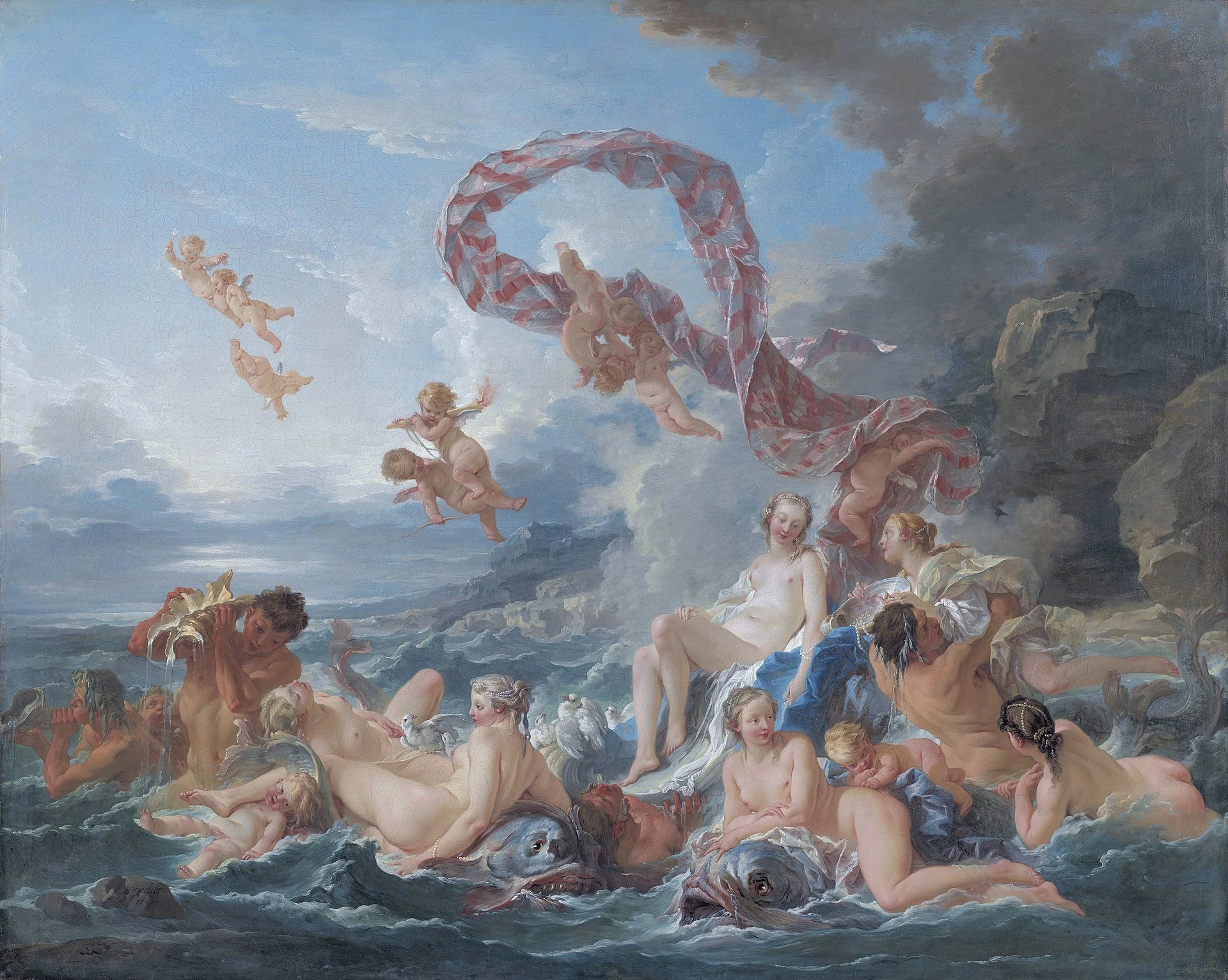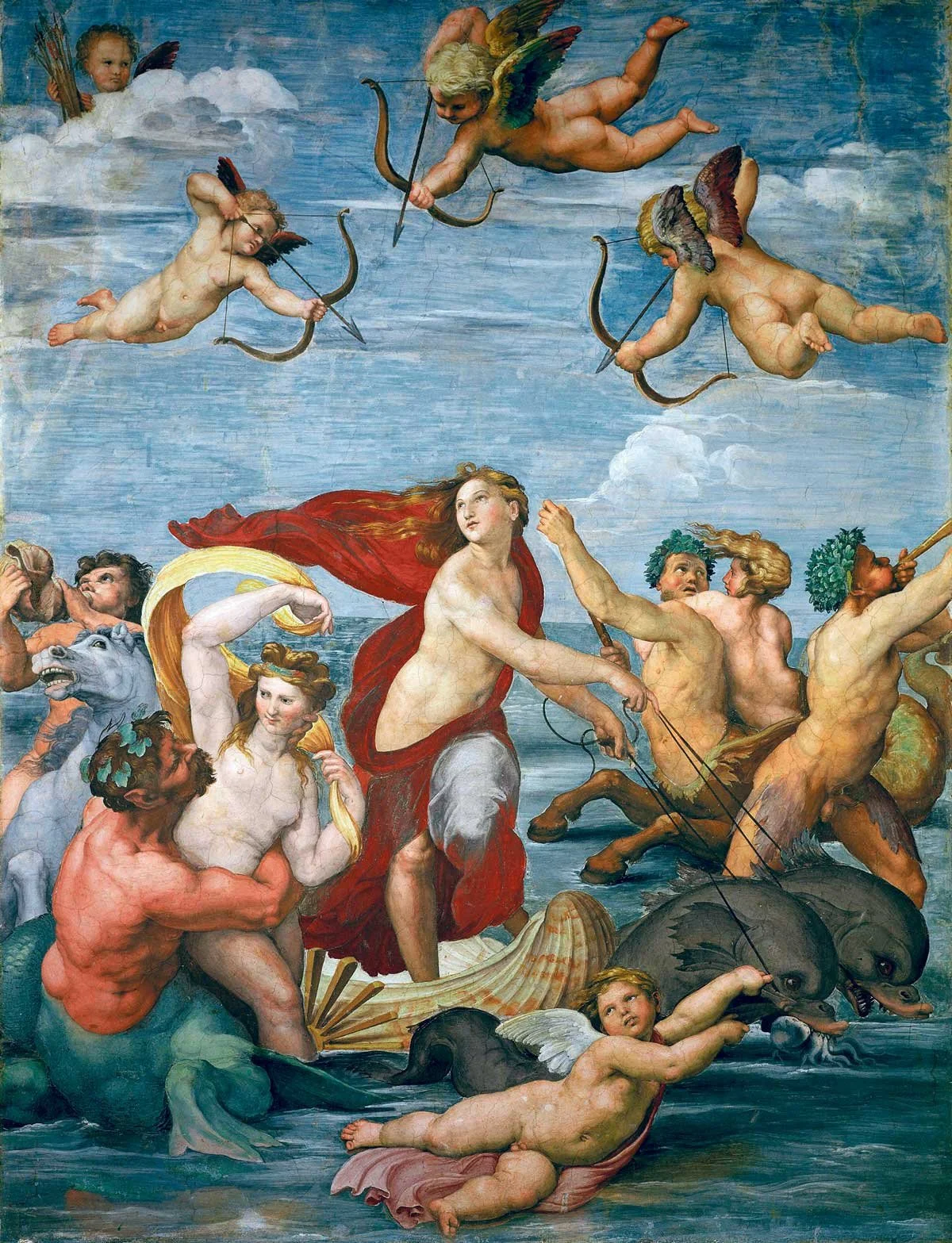Beyond the Gaze: Female Identity and the Siren in Art
The portrayal of sirens in art mirrors societal views on female beauty, power, and desire, illustrating how art has both celebrated and constrained female influence through shifting cultural perspectives. This underscores the importance of amplifying female voices to cultivate a more inclusive art history—essential for understanding the complexities of women's identities.
François Boucher, The Triumph of Venus, 1740. Oil on canvas, 130 x 162 cm. Stockholm: Nationalmuseum
Lust, an intense craving for power, wealth, or sex, has long been seen as a destructive force, often embodied in art and mythology by sirens who symbolize the seductive yet perilous nature of desire. As I delve into the portrayal of sirens throughout history, I find it fascinating how these images reflect societal views on females and how art has been used to control, celebrate, and question female influence.
Even in societies that claim greater freedom, the female body and sexuality still face criticism. I’ve noticed that, despite progress, women’s choices remain debated, reflecting our ongoing struggle for respect and self-determination. By examining the visualization of sirens through time, I hope to gain insight into public attitudes toward women and consider how a more empowering depiction of women could shift our collective perspective on beauty and power.
Unknown, The Siren Vase ,480 BC-470 BC (circa). Red Figure Technique, 34 x 38 x 29 cm. London: The British Museum
The siren, a mythic being rooted in ancient Greek mythology, symbolizes the irresistible pull of temptation.[1] Initially depicted as half-bird, half-woman creatures, sirens lured sailors toward destruction with their enchanting voices.[2] This dangerous charm reflects broader cultural fears in ancient Greece, which often viewed female sexuality and autonomy with suspicion. In a patriarchal society like classical Greece, where women’s roles were largely confined to domestic spaces, the siren myth embodied male anxieties about uncontrolled female desire and the perceived threat of female energy. This narrative – placing the blame for men’s downfall on women – framed them as inherently dangerous and established a long tradition of portraying females as menacing temptresses, reinforcing fears about female autonomy and the power of the female body over male temptation.
As we move into the medieval period, the image of the siren shifts significantly. In Christian allegories, these figures become deeply embedded symbols of lust and moral corruption, illustrating how collective fears evolve over time. Medieval theologians warned against the sirens’ allure, likening them to harlots who led men away from righteousness.[3] The siren, often depicted in illuminated manuscripts – handwritten books that were richly decorated with illustrations – was frequently shown holding mirrors or combs.[4] This reinforced the association between female beauty, vanity, and moral decay. The portrayal of women as seductresses highlights male-dominated societies' view of female sexuality as a threat, and reflects a broader desire to control women's behavior throughout history.[5] It’s intriguing to compare this with today’s society, where women are still often judged as either respectable for adhering to traditional norms or criticized for openly embracing their bodies, underscoring the ongoing struggle over women’s identity and independence.
As creative expression advanced into the Renaissance, sirens and mermaids evolved into more human-like forms, reflecting the era’s fascination with humanism – a movement that emphasized the value and agency of human beings, focusing on individual potential and beauty. Artists like Raphael portrayed these figures with grace and allure, yet maintained a focus on their seductive appeal, as seen in The Triumph of Galatea (1514).[6] This depiction of women as enchantresses positioned them as objects of admiration and warnings of danger, primarily for the male gaze, often stripping them of their agency and reducing them to mere objects of desire, limiting their representation. The absence of women’s own voices and perspectives during this time raises questions about how different their portrayals might have been. It's remarkable that much of art history reflects a predominantly male perspective, and as an art enthusiast, I wish to explore more female viewpoints from these eras. This gap in representation highlights a significant loss in artistic richness, making it essential to elevate female perspectives for a more inclusive understanding of art history.
Raffaello Sanzio da Urbino, The Triumph of Galatea, c. 1512. Oil on canvas, 295 x 225 cm. Rome: Villa Farnesina
Building on the portrayal of lust and sirens, the Baroque and Rococo periods saw art continue to represent women through themes of sensuality and seduction. François Boucher’s The Triumph of Venus (1740) represents the Rococo fascination with love and beauty. Although it doesn’t feature mermaids, it includes sea nymphs and mythological figures that echo siren-like seduction. Boucher’s flowing forms and light, playful atmosphere is typical of Rococo art, emphasizing female allure and temptation. Figures like Venus and mythological nymphs mirrored the siren’s role as captivating yet deceptive. Baroque art’s dramatic intensity and Rococo’s playful elegance framed women as symbols of arousal. Even as art delved into deeper emotions, it often remained focused on beauty as a tool of power or risk—something that could empower women by captivating men or, on the other hand, as a dangerous force leading to temptation and downfall. This one-sided perspective further reduced women to mere figures of desire.
The Romantics and Symbolists of the 19th century reimagined the siren myth, with artists like John William Waterhouse and Gustave Moreau bringing emotional and psychological depth to their portrayals.[7] However, themes of seduction and danger persisted, with sirens still portrayed as enchantresses and symbols of destruction, reflecting lingering anxieties about female attraction. The figure in Waterhouse’s The Siren (1900) gazes at a vulnerable sailor, capturing the tension between lust and peril. Despite exploring the human psyche, these portrayals remained bound to male fears and fantasies. The complexity of women’s inner worlds was rarely acknowledged or modified, suggesting little interest in challenging these established perspectives at the time. Though the artworks of this period are mesmerizing, they often overlook the complexities of women’s inner lives. Their struggles remain hidden beneath layers of male imaginations.
John William Waterhouse, The Siren, 1900. Oil on canvas, 81 x 53 cm.
My research reveals that the siren, as a mythological figure, has been portrayed through a male lens, with narratives reflecting fears about female sexuality and depicting women as dangerous temptresses responsible for men's ruin. Rather than acknowledging the choices men make in pursuing their cravings, women are vilified for supposedly leading men to their downfall, often depicted as intent on causing destruction. This dynamic illustrates how societal power imbalances are expressed and reinforced through visual culture, as women were given little agency over their bodies. As a woman, an artist, and an observer, I long for more layered and authentic depictions of female characters that capture their experiences, resilience, and complexities, rather than reducing them to mere symbols of temptation.
In the 20th and 21st centuries, a fresh generation of artists, including Patricia Piccinini, began to challenge traditional portrayals of women. Piccinini’s The Long Awaited (2008) presents a hybrid creature that defies conventional beauty standards, inviting viewers to reconsider the boundaries between nature, technology, and empathy.[8] In this period, we see females gradually gaining more independence in both life and art, with female artists beginning to shape how women are portrayed. This shift paved the way for richer, more complex portrayals of women and mermaids, allowing artists to explore deeper emotional connections beyond traditional depictions of passive allure. These modern reinterpretations highlight visual culture’s potential to challenge outdated narratives, yet they also underscore how long it took for change to begin. It raises the question: if men had continued to dominate cultural production, would our perspectives on female beauty and desire ever have evolved?
However, even in contemporary art, the influence of the male gaze persists. In his Sexy Robot series, Hajime Sorayama blends futuristic aesthetics with themes of objectification, exemplified by Mermaid Sexy Robot (2019),[9] which combines mermaid imagery with robotic sensuality. These works highlight the fact that despite progress, women are still often depicted as alluring yet emotionless, stripped of complexity and strength. If men portrayed women more respectfully in art and media, it could influence social beliefs, which may lead young men to develop a more respectful view of women.
This invites us to consider how collective perspectives might evolve if all artists – regardless of gender – were to present women with greater nuance and depth. Historically, women have lacked rights and representation, and despite some advancements, much work remains. I recognize the importance of women taking charge of their own representation, rather than relying on the male gaze for validation. Though often framed as freedom, this can reinforce historical male views on femininity, as seen in mermaid visualization. We must reclaim our narratives and challenge these frameworks. Women will continue to use their voices and artistic expression to reshape perceptions, yet men must also reconsider how they view and portray women.
The depiction of sirens in art has long mirrored society’s shifting views on female beauty, power, and desire. Ancient Greek mythology, with sirens luring sailors to their doom, and medieval Christian allegories linking sirens to vanity and moral decay, reflect male anxieties about female influence and autonomy. Renaissance works like Raphael’s The Triumph of Galatea further reinforced these views, presenting female allure as both captivating and perilous. Even in the 19th century, John William Waterhouse’s The Siren cast women as objects of desire and destruction. In contrast, contemporary artists like Patricia Piccinini offer nuanced portrayals that emphasize empathy and resilience, inviting us to see women’s identities beyond the reductive lens of temptation. By questioning outdated narratives and amplifying female voices, we can foster an art culture that honors the depth and agency of women’s experiences, reshaping our understanding of beauty and power and creating a more inclusive and empowering artistic narrative.
Literature
[1] "Siren," Encyclopaedia Britannica, https://www.britannica.com/topic/Siren-Greek-mythology.
[2] The Siren Painter, The Siren Vase. 480BC-470BC (circa). The British Museum, https://www.bmimages.com/preview.asp?image=01613406857.
[3] Isidore of Seville, Etymologies, Book 11, 3:30-31.
[4]Luttrell Psalter. Ca 1325-1335. British Library archive, https://imagesonline.bl.uk/asset/17815.
[5] Eclectic Light, "Delightfully Deadly: Sirens in Paintings," https://eclecticlight.co/2020/01/19/delightfully-deadly-sirens-in-paintings/.
[6] "The Triumph of Galatea," History Today, https://www.historytoday.com/archive/foundations/triumph-galatea.
[7] Art Guide, "John William Waterhouse: Siren," https://www.artguide.org/john-william-waterhouse/siren/.
[8] National Portrait Gallery, [In The Flesh | Patricia Piccinini], [Mar 12, 2015]. YouTube. https://www.youtube.com/watch?v=3XKSpWxR5tA&ab_channel=NationalPortraitGallery.
[9] Hype Museum, Mermaid Sexy Robot, https://hypemuseum.jp/products/mermaid-sexy-robot-hajime-sorayama.




